He Subject Matter of Prehistoric Art Concentrates on Sources of Food and

In the history of fine art, prehistoric art is all art produced in preliterate, prehistorical cultures beginning somewhere in very belatedly geological history, and generally continuing until that culture either develops writing or other methods of record-keeping, or makes meaning contact with another civilisation that has, and that makes some record of major historical events. At this indicate ancient fine art begins, for the older literate cultures. The cease-date for what is covered by the term thus varies greatly between unlike parts of the world.[one]
The primeval man artifacts showing testify of workmanship with an artistic purpose are the subject of some debate. It is clear that such workmanship existed by 40,000 years ago in the Upper Paleolithic era, although it is quite possible that information technology began before. In September 2018, scientists reported the discovery of the earliest known drawing by Homo sapiens, which is estimated to exist 73,000 years old, much earlier than the 43,000 years old artifacts understood to be the earliest known mod human drawings establish previously.[2]
Engraved shells created by Human being erectus dating every bit far back as 500,000 years ago have been found, although experts disagree on whether these engravings can be properly classified as 'fine art'.[three] From the Upper Paleolithic through to the Mesolithic, cave paintings and portable fine art such equally figurines and chaplet predominated, with decorative figured workings besides seen on some utilitarian objects. In the Neolithic bear witness of early pottery appeared, as did sculpture and the structure of megaliths. Early rock fine art too first appeared during this period. The appearance of metalworking in the Bronze Age brought additional media available for use in making fine art, an increase in stylistic diversity, and the cosmos of objects that did not accept whatever obvious office other than art. Information technology also saw the development in some areas of artisans, a class of people specializing in the production of art, besides as early on writing systems. By the Iron Age, civilizations with writing had arisen from Ancient Arab republic of egypt to Ancient People's republic of china.
Many indigenous peoples from effectually the world continued to produce artistic works distinctive to their geographic area and culture, until exploration and commerce brought record-keeping methods to them. Some cultures, notably the Maya civilization, independently adult writing during the time they flourished, which was then subsequently lost. These cultures may be classified as prehistoric, especially if their writing systems have not been deciphered.
Paleolithic era [edit]
Lower and Middle Paleolithic [edit]


The earliest undisputed art originated with the Human sapiens Aurignacian archaeological culture in the Upper Paleolithic. Nevertheless, there is some evidence that the preference for the artful emerged in the Middle Paleolithic, from 100,000 to 50,000 years ago. Some archaeologists have interpreted certain Eye Paleolithic artifacts as early examples of artistic expression.[5] [6] The symmetry of artifacts, evidence of attention to the detail of tool shape, has led some investigators to conceive of Acheulean hand axes and especially laurel points equally having been produced with a degree of artistic expression.
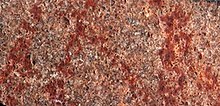
Claimed "Oldest known drawing by human easily", discovered in Blombos Cave in South Africa. Estimated to exist 73,000 years old.[2]
Similarly, a zigzag engraving supposedly fabricated with a shark tooth on a freshwater Pseudodon beat DUB1006-fL around 500,000 years ago (i.e. well into the Lower Paleolithic), associated with Homo erectus, could be the earliest bear witness of artistic activeness, merely the actual intent behind this geometric ornament is not known.[4]
There are other claims of Middle Paleolithic sculpture, dubbed the "Venus of Tan-Tan" (before 300 kya)[7] and the "Venus of Berekhat Ram" (250 kya). In 2002 in Blombos cave, situated in South Africa, stones were discovered engraved with grid or cantankerous-hatch patterns, dated to some lxx,000 years ago. This suggested to some researchers that early Homo sapiens were capable of brainchild and production of abstract fine art or symbolic fine art. Several archaeologists including Richard Klein are hesitant to take the Blombos caves as the first example of actual art.
In September 2018 the discovery in South Africa of the primeval known drawing by Man sapiens was announced, which is estimated to be 73,000 years onetime, much earlier than the 43,000 years old artifacts understood to be the primeval known modern homo drawings found previously.[2] The drawing shows a crosshatched pattern fabricated upwards of nine fine lines. The sudden termination of all of the lines on the fragment edges indicate that the pattern originally extended over a larger surface.[8] It is likewise estimated that the pattern was most likely more complex and structured in its entirety than shown on the discovered expanse. Initially, when this drawing was found, there was much debate. To prove that this drawing was created by Homo Sapiens, French team members who specialized in chemical analysis of pigments, reproduced the same lines using a diverseness of techniques.[9] They concluded that the lines making up the drawing were intentional and were virtually likely made with ocher. This discovery adds farther dimensions to understanding the beliefs and cognition of early homo sapiens.
Neanderthals may have made art. Painted designs in the caves of La Pasiega (Cantabria), a hand stencil in Maltravieso (Extremadura), and ruddy-painted speleothems in Ardales (Andalusia) are dated to 64,800 years ago, predating by at least 20,000 years the inflow of modernistic humans in Europe.[x] [11] In July 2021, scientists reported the discovery of a bone carving, i of the world'southward oldest works of art, made by Neanderthals nigh 51,000 years ago.[12] [xiii]
Upper Paleolithic [edit]

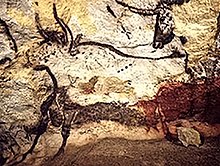
In November 2018, scientists reported the discovery of the oldest known figurative art painting, over twoscore,000 (perhaps as sometime as 52,000) years old, of an unknown beast, in the cave of Lubang Jeriji Saléh on the Indonesian island of Borneo.[xiv] [15]
Some of the oldest undisputed works of figurative fine art were institute in the Schwäbische Alb, Baden-Württemberg, Federal republic of germany. The earliest of these, the Venus figurine known equally the Venus of Hohle Fels and the Lion-man figurine, date to some xl,000 years agone.
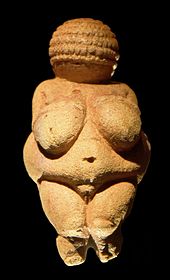
Further depictional art from the Upper Palaeolithic period (broadly twoscore,000 to 10,000 years ago) includes cave painting (e.thousand., those at Chauvet, Altamira, Pech Merle, Arcy-sur-Cure and Lascaux) and portable art: Venus figurines like the Venus of Willendorf, every bit well as animal carvings like the Swimming Reindeer, Wolverine pendant of Les Eyzies, and several of the objects known every bit bâtons de commandement.
Paintings in Pettakere cave on the Indonesian island of Sulawesi are upwards to 40,000 years one-time, a similar date to the oldest European cave art, which may propose an older mutual origin for this type of fine art, mayhap in Africa.[xvi]
Monumental open up-air art in Europe from this catamenia includes the rock-art at Côa Valley and Mazouco in Portugal, Domingo García and Siega Verde in Spain, and Rocher gravé de Fornols in French republic.
A cave at Turobong in Republic of korea containing human remains has been found to contain carved deer bones and depictions of deer that may be as much equally forty,000 years erstwhile.[17] Petroglyphs of deer or reindeer plant at Sokchang-ri may also date to the Upper Paleolithic. Potsherds in a manner reminiscent of early Japanese work accept been found at Kosan-ri on Jeju island, which, due to lower sea levels at the time, would have been attainable from Nippon.[eighteen]
The oldest petroglyphs are dated to approximately the Mesolithic and late Upper Paleolithic boundary, about 10,000 to 12,000 years ago. The earliest undisputed African rock fine art dates back about ten,000 years. The kickoff naturalistic paintings of humans institute in Africa appointment dorsum about viii,000 years patently originating in the Nile River valley, spread every bit far west as Mali about x,000 years ago. Noted sites containing early on art include Tassili n'Ajjer in southern Algeria, Tadrart Acacus in Libya (A Unesco Globe Heritage site), and the Tibesti Mountains in northern Chad.[nineteen] Rock carvings at the Wonderwerk Cavern in South Africa have been dated to this age.[20] Contentious dates as far back as 29,000 years take been obtained at a site in Tanzania. A site at the Apollo eleven Cave complex in Namibia has been dated to 27,000 years.
Göbekli Tepe in Turkey has circles of massive T-shaped stone pillars dating back to the 10th–8th millennium BCE; the world's oldest known megaliths. Many of the pillars are decorated with abstract, enigmatic pictograms and carved animal reliefs.
Asia [edit]

Asia was the cradle for several significant civilizations, most notably those of China and Southern asia. The prehistory of eastern Asia is peculiarly interesting, as the relatively early on introduction of writing and historical tape-keeping in Prc has a notable impact on the immediately surrounding cultures and geographic areas. Little of the very rich traditions of the art of Mesopotamia counts every bit prehistoric, as writing was introduced and then early at that place, just neighbouring cultures such as Urartu, Luristan and Persia had significant and complex artistic traditions.

A possible representation of a "yogi" or "proto-Shiva", 2600–1900 BCE
Azerbaijan [edit]
The Gobustan National Park reserve located at the due south-east of the Greater Caucasus Mountains in Azerbaijan, threescore km away from Baku date back more than than 12 1000 years ago. The reserve has more than six,000 stone carvings depicting more often than not hunting scenes, human being and animal figures. There are besides longship illustrations like to Viking ships. Gobustan is besides characterized past its natural musical rock chosen Gavaldash (tambourine stone).[21] [22] [23] [24] [25] [ self-published source? ]
Indian sub-continent [edit]
The primeval Indian paintings were the rock paintings of prehistoric times, the petroglyphs every bit found in places like the Rock Shelters of Bhimbetka, and some of them are dated to circa eight,000 BC.[26] [27] [28] [29] [thirty] The Indus Valley civilization produced fine small stamp seals and sculptures, and may take been literate, but subsequently its collapse there are relatively few creative remains until the literate period, probably as perishable materials were used.
China [edit]

Prehistoric artwork such every bit painted pottery in Neolithic Red china tin can exist traced back to the Yangshao civilisation and Longshan culture of the Xanthous River valley. During Cathay'southward Bronze Age, Chinese of the ancient Shang Dynasty and Zhou Dynasty produced multitudes of Chinese ritual bronzes, which are elaborate versions of ordinary vessels and other objects used in rituals of ancestor veneration, decorated with taotie motifs and by the late Shang Chinese bronze inscriptions. Discoveries in 1987 in Sanxingdui in cardinal Communist china revealed a previously unknown pre-literate Bronze Historic period civilization whose artefacts included spectacular very large bronze figures (example left), and which appeared culturally very different from the gimmicky belatedly Shang, which has always formed office of the account of the continuous tradition of Chinese civilisation.
Nippon [edit]

Co-ordinate to archeological evidence, the Jōmon people in aboriginal Japan were amongst the first to develop pottery, dated from the 11th millennium BCE. With growing sophistication, the Jōmon created patterns by impressing the moisture clay with braided or unbraided cord and sticks.
Korea [edit]

A Korean Neolithic pot found in Busan, 3500 BCE
The earliest examples of Korean fine art consist of Stone Age works dating from 3000 BCE. These mainly consist of votive sculptures, although petroglyphs take besides been recently rediscovered. Stone arts, elaborate stone tools, and potteries were too prevalent.
This early on catamenia was followed past the fine art styles of various Korean kingdoms and dynasties. In these periods, artists frequently adopted Chinese style in their artworks. However, Koreans non but adopted but also modified Chinese civilization with a native preference for simple elegance, purity of nature and spontaneity. This filtering of Chinese styles later on influenced Japanese artistic traditions, due to cultural and geographical circumstances.
The prehistory of Korean ends with the founding of the Three Kingdoms of Korea, which are documented in the Samguk Sagi, a 12th-century CE text written in Classical Chinese (the written linguistic communication of the literati in traditional Korea), as starting time in the 1st century BCE; some mention of earlier history is also made in Chinese texts, like the 3rd-century CE Sanguo Zhi.
Jeulmun period [edit]
Clearer prove of culture emerges in the late Neolithic, known in Korea as the Jeulmun pottery menses, with pottery like to that plant in the next regions of China, decorated with Z-shaped patterns. The primeval Neolithic sites with pottery remains, for example Osan-ri, date to 6000–4500 BCE.[xviii] This pottery is characterized past rummage patterning, with the pot frequently having a pointed base. Ornaments from this time include masks made of vanquish, with notable finds at Tongsam-dong, Osan-ri, and Sinam-ri. Mitt-shaped clay figurines have been found at Nongpo-dong.[31]
Mumun period [edit]

Large Middle Mumun (c. 800 BCE) storage vessel unearthed from a pit-house in or near Daepyeong
During the Mumun pottery period, roughly between 1500 BCE and 300 BCE, agriculture expanded, and evidence of larger-scale political structures became apparent, as villages grew and some burials became more elaborate. Megalithic tombs and dolmens throughout Korea date to this fourth dimension. The pottery of the time is in a distinctive undecorated way. Many of these changes in style may accept occurred due to immigration of new peoples from the northward, although this is a subject of debate.[32] At a number of sites in southern Korea there are stone fine art panels that are thought to date from this period, mainly for stylistic reasons.[33]
While the exact date of the introduction of bronzework into Korea is besides a matter of fence, it is clear that bronze was beingness worked by virtually 700 BCE. Finds include stylistically distinctive daggers, mirrors, and chugalug buckles, with show by the 1st century BCE of a widespread, locally distinctive, bronzeworking culture.[34]
Protohistoric Korea [edit]

The time between 300 BCE and the founding and stabilization of the Iii Kingdoms around 300 CE is characterized artistically and archaeologically by increasing trade with Red china and Japan, something that Chinese histories of the time corroborate. The expansionist Chinese invaded and established commanderies in northern Korea as early as the 1st century BCE; they were driven out past the 4th century CE.[35] The remains of some of these, especially that of Lelang, almost modern Pyongyang, have yielded many artifacts in a typical Han style.[36]
Chinese histories also record the beginnings of iron works in Korea in the 1st century BCE. Stoneware and kiln-fired pottery as well appears to date from this time, although in that location is controversy over the dates.[37] Pottery of distinctly Japanese origin is found in Korea, and metalwork of Korean origin is found in northeastern China.[38]
Steppes Art [edit]

Late 7th-century Scythian plaque of a leopard
Superb samples of Steppes art - generally gold jewellery and trappings for horse - are found over a vast expanses of land stretching from Republic of hungary to Mongolia. Dating from the period between the 7th and third centuries BCE, the objects are commonly diminutive, equally may exist expected from nomadic people always on the move. Fine art of the steppes is primarily an animate being art, i.e., combat scenes involving several animals (real or imaginary) or single creature figures (such as gold stags) predominate. The best known of the various peoples involved are the Scythians, at the European end of the steppe, who were peculiarly likely to coffin gold items.
Amidst the well-nigh famous finds was fabricated in 1947, when the Soviet archaeologist Sergei Rudenko discovered a majestic burial at Pazyryk, Altay Mountains, which featured - amongst many other important objects - the most ancient extant pile rug, probably fabricated in Persia. Unusually for prehistoric burials, those in the northern parts of the expanse may preserve organic materials such every bit woods and textiles that normally would decay. Steppes people both gave and took influences from neighbouring cultures from Europe to China, and later Scythian pieces are heavily influenced past ancient Greek way, and probably often made by Greeks in Scythia.
Nearly East [edit]
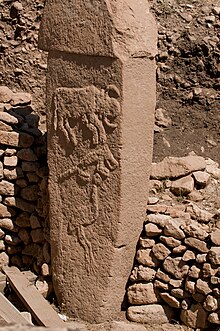
The Ain Sakhri Lovers from modern Israel, is a small Natufian etching in calcite, from about 9,000 BCE. Around the same time, the extraordinary site of Göbekli Tepe in eastern Turkey was begun. During the first phase, belonging to the Pre-Pottery Neolithic A (PPNA), circles of massive but neatly shaped T-shaped stone pillars were erected – the world's oldest known megaliths.[39] More than than 200 pillars in about xx circles are currently known through geophysical surveys. Each pillar has a height of up to 6 m (20 ft) and weighs up to 10 tons. They are fitted into sockets that were hewn out of the bedrock.[40] In the 2nd phase, belonging to the Pre-Pottery Neolithic B (PPNB), the erected pillars are smaller and stood in rectangular rooms with floors of polished lime. On the smoothed surfaces of the pillars in that location are reliefs of animals, abstruse patterns, and some human figures.
By convention, prehistory in the Virtually Due east is taken to go on until the rising of the Achaemenid Empire in the sixth century BCE, although writing existed in the region from nearly two,000 years earlier. On that footing the very rich and long tradition of the art of Mesopotamia, also as Assyrian sculpture, Hittite art and many other traditions such equally the Luristan bronzes all fall under prehistoric fine art, even if covered with texts extolling the ruler, as many Assyrian palace reliefs are.
Europe [edit]
Stone Age [edit]

The Art of the Upper Paleolithic includes carvings on antler and os, especially of animals, also every bit the so-called Venus figurines and cave paintings, discussed above. Despite a warmer climate, the Mesolithic period undoubtedly shows a falling-off from the heights of the preceding period. Rock art is constitute in Scandinavia and northern Russia, and around the Mediterranean in eastern Spain and the primeval of the Stone Drawings in Valcamonica in northern Italy, but non in between these areas.[41] [42] Examples of portable art include painted pebbles from the Azilian culture which succeeded the Magdalenian, and patterns on utilitarian objects, like the paddles from Tybrind Vig, Denmark. The Mesolithic statues of Lepenski Vir at the Iron Gate, Serbia date to the 7th millennium BCE and represent either humans or mixtures of humans and fish. Elementary pottery began to develop in various places, even in the absence of farming.
Mesolithic [edit]
Compared to the preceding Upper Paleolithic and the following Neolithic, at that place is rather less surviving art from the Mesolithic. The Stone art of the Iberian Mediterranean Basin, which probably spreads across from the Upper Paleolithic, is a widespread miracle, much less well known than the cave-paintings of the Upper Paleolithic, with which it makes an interesting contrast. The sites are now generally cliff faces in the open air, and the subjects are now generally human rather than animal, with large groups of small figures; there are 45 figures at Roca dels Moros. Clothing is shown, and scenes of dancing, fighting, hunting and food-gathering. The figures are much smaller than the animals of Paleolithic fine art, and depicted much more schematically, though often in energetic poses.[43] A few small-scale engraved pendants with suspension holes and unproblematic engraved designs are known, some from northern Europe in bister, and one from Starr Carr in Britain in shale.[44]
The rock art in the Urals appears to show similar changes subsequently the Paleolithic, and the wooden Shigir Idol is a rare survival of what may well have been a very common material for sculpture. It is a plank of larch carved with geometric motifs, but topped with a human being caput. Now in fragments, it would apparently have been over 5 metres tall when fabricated.[45]
Neolithic [edit]
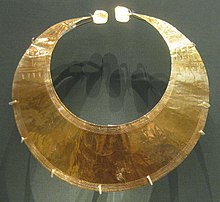
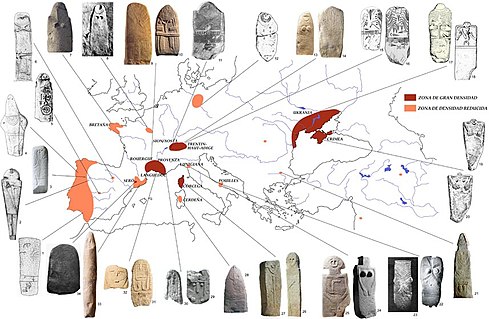
Map with distribution of statue-menhir in Europe.[ane] Photos and pictures: 1y four.-Bueno et al. 2005; 2.-Santonja y Santonja 1978; three.-Jorge 1999; five.-Portela y Jiménez 1996; six.-Romero 1981; 7.-Helgouach 1997; eight.- Tarrete 1997; nine, 10, thirteen, 14, 29, 30, 31, 32.-Philippon 2002; eleven.-Corboud y Curdy 2009; 12.-Muller 1997; fifteen, 16, 17, 18, 19, 20, 21, 22, 23 Arnal 1976; 24 y 25.- Augusto 1972; 26 y 27.- Grosjean 1966; 34.- López et al. 2009.
In Central Europe, many Neolithic cultures, like Linearbandkeramic, Lengyel and Vinča,[46] produced female (rarely male person) and animal statues that can exist called art, and elaborate pottery ornament in, for example, the Želiesovce and painted Lengyel style.
Megalithic (i.e., large stone) monuments are institute in the Neolithic Era from Malta to Portugal, through France, and across southern England to most of Wales and Ireland. They are also found in northern Federal republic of germany and Poland, as well every bit in Egypt in the Sahara desert (at Nabta Playa and other sites). The all-time preserved of all temples and the oldest free standing structures are the Megalithic Temples of Malta. They showtime in the fifth millennium BC, though some authors speculate on Mesolithic roots. One of the all-time-known prehistoric sites is Stonehenge, part of the Stonehenge World Heritage Site which contains hundreds of monuments and archaeological sites. Monuments accept been found throughout well-nigh of Western and Northern Europe, notably at Carnac, France.

Archway rock with megalithic art at Newgrange
The large mound tomb at Newgrange, Republic of ireland, dating to around 3200 BC, has its entrance marked with a massive stone carved with a circuitous design of spirals. The mound at nearby Knowth has big flat rocks with rock engravings on their vertical faces all around its circumference, for which various meanings have been suggested, including depictions of the local valley, and the oldest known prototype of the Moon. Many of these monuments were megalithic tombs, and archaeologists speculate that almost have religious significance. Knowth is reputed to take approximately one third of all megalithic fine art in Western Europe.
In the central Alps, the Camunni made some 350,000 petroglyphs: see Rock Drawings in Valcamonica.
Bronze Age [edit]

During the 3rd millennium BCE, the Bronze Historic period began in Europe, bringing with it a new medium for art. The increased efficiency of bronze tools also meant an increase in productivity, which led to a surplus — the showtime step in the cosmos of a class of artisans. Because of the increased wealth of order, luxury goods began to be created, especially decorated weapons.
Examples include ceremonial bronze helmets, ornamental ax-heads and swords, elaborate instruments such as lurer, and other ceremonial objects without a practical purpose, such as the oversize Oxborough Dirk. Special objects were made in gold; many more than gold objects accept survived from Western and Key Europe than from the Atomic number 26 Age, many mysterious and strange objects ranging from lunulas, apparently an Irish speciality, the Mold Cape and Golden hats. Pottery from Central Europe can exist elaborately shaped and decorated. Rock art, showing scenes from the religious rituals have been establish in many areas, for example in Bohuslän, Sweden and the Val Camonica in northern Italy.
In the Mediterranean, the Minoan civilization was highly developed, with palace complexes from which sections of frescos have been excavated. Contemporary Ancient Egyptian art and that of other advanced Most Eastern cultures can no longer be treated as "prehistoric".
Iron Age [edit]

The Iron Historic period saw the development of anthropomorphic sculptures, such as the warrior of Hirschlanden, and the statue from the Glauberg, Frg. Hallstatt artists in the early Atomic number 26 Age favored geometric, abstract designs perhaps influenced by trade links with the Classical world.
The more elaborate and curvilinear La Tène fashion developed in Europe in the later Iron Age from a middle in the Rhine valley only information technology before long spread beyond the continent. The rich chieftain classes announced to have encouraged ostentation and Classical influences such as bronze drinking vessels adjure to a new mode for vino drinking. Communal eating and drinking were an important part of Celtic guild and culture and much of their art was oft expressed through plates, knives, cauldrons and cups. Horse tack and weaponry were also decorated. Mythical animals were a common motif along with religious and natural subjects and their depiction is a mix between the naturalistic and the stylized. Megalithic fine art was yet sometimes practiced, examples include the carved limestone pillars of the sanctuary at Entremont in modern-day France. Personal adornment included torc necklaces whilst the introduction of coinage provided a further opportunity for creative expression. The coins of this period are derivatives of Greek and Roman types, only showing the more exuberant Celtic artistic manner.
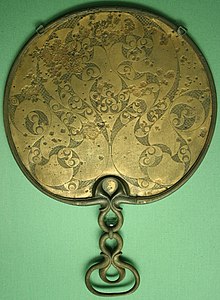
A 1st century BCE mirror found in Desborough, England, showing the spiral and trumpet motif
The famous late 4th century BCE Waldalgesheim chariot burial in the Rhineland produced many fine examples of La Tène art including a statuary flagon and bronze plaques with repoussé human figures. Many pieces had curvy, organic styles though to exist derived from Classical tendril patterns.
In much of western Europe elements of this artistic style can be discerned surviving in the art and architecture of the Roman colonies. In detail in Britain and Ireland in that location is a tenuous continuity through the Roman menstruum, enabling Celtic motifs to resurface with new vigour in the Christian Insular art from the 6th century onwards.
The sophisticated Etruscan culture developed from the 9th to 2d centuries, with considerable influence from the Greeks, before finally being absorbed past the Romans. By the end of the flow they had developed writing, but early Etruscan art tin can be called prehistoric.
Africa [edit]
Aboriginal Egypt falls outside the scope of this article; it had a close relationship with the Sudan in particular, known in this period as Nubia, where at that place were advanced cultures from the quaternary millennium BCE, such as the "A-Group", "C-Group", and the Kingdom of Kush.
Southern Africa [edit]
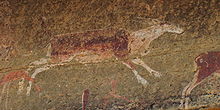
In September 2018, scientists from the Academy of Bergen, the University of Bordeaux and the University of the Witwatersrand together reported the discovery of the primeval known drawing by Homo sapiens at Blombos Cave, South Africa which is estimated to be 73,000 years old, much earlier than the 43,000 years erstwhile artifacts understood to exist the primeval known modern human drawings found previously.[2]
At that place is a significant torso of stone painting in the region effectually Matobo National Park of Zimbabwe dating from equally early as 6000 BCE to 500 CE.[47]
Meaning San stone paintings exist in the Waterberg area above the Palala River and effectually Drakensberg in S Africa, some of which are considered to derive from the period 8000 BCE. These images are very clear and depict a variety of human and wildlife motifs, especially antelope. There appears to exist a fairly continuous history of rock painting in this area; some of the art clearly dates into the 19th century. They include depictions of horses with riders, which were not introduced to the area until the 1820s.[48]
Namibia, in addition to the Apollo eleven Cave complex, has a pregnant array of San rock art near Twyfelfontein. This work is several one thousand years old, and appears to end with the arrival of pastoral tribes in the surface area.[49]
Horn of Africa [edit]

Laas Geel is a complex of caves and rock shelters in northwestern Somalia. Famous for their rock art, the caves are located in a rural area on the outskirts of Hargeisa. They contain some of the earliest known cave paintings in the Horn of Africa, many of which depict pastoral scenes. Laas Geel's rock art is estimated to appointment back to somewhere betwixt 9,000–8,000 and 3,000 BCE.
In 2008, archaeologists also announced the discovery of cavern paintings in Somalia's northern Dhambalin region, which the researchers suggest includes ane of the earliest known depictions of a hunter on horseback. The rock art is in the Ethiopian-Arabian manner, dated to grand to 3000 BCE.[50] [51]
Other prehistoric art in the Horn region include stone megaliths and engravings, some of which are three,500 years old. The town of Dillo in Ethiopia has a hilltop covered with stone stelae. It is one of several such sites in southern Ethiopia dating from historic period[ clarification needed ] (10th-14th centuries).[52]
Saharan Africa [edit]

The early art of this region has been divided into five periods:
- Bubalus Period, roughly 12-viii kya
- Round Head Period, roughly ten-8 kya
- Pastoral Flow, roughly seven.v-four kya
- Horse Period, roughly iii-two kya
- Camel Menses, 2,000 years ago to the present

Works of the Bubalus menstruation span the Sahara, with the finest piece of work, carvings of naturalistically depicted megafauna, concentrated in the central highlands. The Round Head Catamenia is dominated by paintings of strangely shaped human forms, and few animals, suggesting the artists were foragers. These works are largely limited to Tassili n'Ajjer and the Tadrart Acacus. Toward the cease of the menstruation, images of domesticated animals, too as decorative wear and headdresses appear. Pastoral Period fine art was more focused on domestic scenes, including herding and dancing. The quality of artwork declined, every bit figures became more simplified.[53]
The Equus caballus Menstruation began in the eastern Sahara and spread west. Depictions from this period include carvings and paintings of horses, chariots, and warriors with metal weapons, although there are also frequent depictions of wildlife such equally giraffes. Humans are generally depicted in a stylized way. Some of the chariot fine art bears resemblance to temple carvings from aboriginal Egypt. Occasionally, art panels are accompanied past Tifinagh script, still in use by the Berber people and the Tuareg today; however, modern Tuareg are generally unable to read these inscriptions. The final Camel menstruum features carvings and paintings in which camels predominate, but also include humans with swords, and later, guns; the art of this fourth dimension is relatively rough.[54]
Northward Africa [edit]
The Americas [edit]
North America [edit]

Belonging in the Lithic stage, the oldest known fine art in the Americas is the Vero Beach os, possibly a mammoth bone, etched with a profile of walking mammoth that dates back to 11,000 BCE.[55] The oldest known painted object in the Americas is the Cooper Bison Skull from 10,900 to 10,200 BCE.[56]
Mesoamerica [edit]
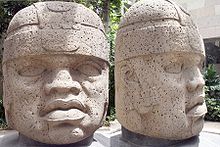
The ancient Olmec "Bird Vessel" and basin, both ceramic and dating to circa 1000 BC as well as other ceramics were produced in kilns capable of exceeding approximately 900 °C. The only other prehistoric culture known to accept accomplished such high temperatures is that of Ancient Egypt.[57]
Much Olmec art is highly stylized and uses an iconography cogitating of the religious significant of the artworks. Some Olmec art, still, is surprisingly naturalistic, displaying an accuracy of depiction of human anatomy perhaps equaled in the pre-Columbian New World only past the best Maya Classic-era art. Olmec art-forms emphasize monumental statuary and modest jade carvings. A mutual theme is to be found in representations of a divine jaguar. Olmec figurines were also found abundantly through their period.
Due south America [edit]
Lithic historic period art in South America includes Monte Alegre civilisation stone paintings created at Caverna da Pedra Pintada dating back to 9250–8550 BCE.[58] [59] Guitarrero Cavern in Republic of peru has the earliest known textiles in South America, dating to 8000 BCE.[60]
Republic of peru and the central Andes [edit]
Lithic and preceramic periods [edit]
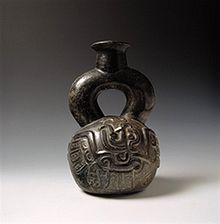
Peru, including an area of the central Andes stretching from the northern office of the country to northern Chile, has a rich cultural history, with prove of human being habitation dating to roughly 10,000 BCE.[61] Prior to the emergence of ceramics in this region around 1850 BCE, cave paintings and beads have been found. These finds include rock paintings that controversially date as far dorsum as 9500 BCE in the Toquepala Caves.[62] Burial sites in Peru like one at Telarmachay as old as 8600-7200 BCE contained evidence of ritual burying, with red ocher and bead necklaces.[63]
The earliest ceramics that appear in Peru may have been imported from the Validivia region; indigenous pottery production almost certainly arrived in the highlands around 1800 BCE at Kotosh, and on the coast at La Florida c. 1700 BCE. Older calabash gourd vessels with human faces burned into them were found at Huaca Prieta, a site dating to 2500-2000 BCE[64] Huaca Prieta likewise contained some early patterned and dyed textiles made from twisted plant fibers.[65]
Initial Catamenia and First Horizon [edit]
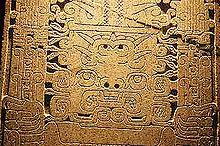
The Initial Flow in Central Andean cultures lasted roughly from 1800 BCE to 900 BCE. Textiles from this time found at Huaca Prieta are of amazing complication, including images such every bit venereal whose claws transform into snakes, and double-headed birds. Many of these images are similar to optical illusions, where which epitome dominates depends in part on which the viewer chooses to see. Other portable artwork from this time includes busy mirrors, bone and beat out jewelry, and unfired clay female person effigies.[66] Public architecture, including works estimated to require the motion of more than 100,000 tons of stone, are to be found at sites like Kotosh, El Paraíso, Republic of peru, and La Galgada (archaeological site). Kotosh, a site in the Andean highlands, is especially noted as the site of the Temple of the Crossed Easily, in which there are ii reliefs of crossed forearms, i pair male, one pair female person.[67] Also of annotation is one of South America'southward largest ceremonial sites, Sechín Alto. This site'due south crowning piece of work is a twelve-story platform, with stones incised with military themes.[68] The architecture and art of the highlands, in particular, laid downward the groundwork for the ascension of the Chavín culture.[69]
The Chavín civilization dominated the central Andes during the First Horizon, offset around 900 BCE, and is mostly divided into ii stages. The beginning, running until about 500 BCE, represented a pregnant cultural unification of the highland and coastal cultures of the time. Imagery in all way of fine art (textiles, ceramics, jewelry, and architectural) included sometimes fantastic imagery such every bit jaguars, snakes, and man–animal composites, much of it seemingly inspired by the jungles to the eastward.[70]
The later stage of the Chavín culture is primarily represented by a significant architectural expansion of the Chavín de Huantar site around 500 BCE, accompanied by a prepare of stylistic changes. This expansion included, amongst other changes, over forty large stone heads, whose reconstructed positions represent a transformation from human to supernatural animal visages. Much of the other art at the circuitous from this time contains such supernatural imagery.[71] The portable art associated with this time included sophisticated metalworking, including alloying of metals and soldering.[72] Textiles plant at sites like Karwa clearly depict Chavín cultural influences,[73] and the Cupisnique style of pottery disseminated by the Chavín would set standards all across the region for later cultures.[74] (The vessel pictured at the pinnacle of this commodity, while from the later Moche culture, is representative of the stirrup-spouted vessels of the Chavín.)
Early Intermediate Menses [edit]
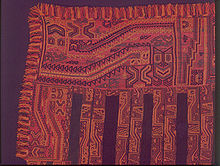
A Paracas Drape dating from 200 CE
The Early Intermediate Period lasted from nigh 200 BCE to 600 CE. Late in the First Horizon, the Chavín culture began to decline, and other cultures, predominantly in the coastal areas, began to develop. The earliest of these was the Paracas culture, centered on the Paracas Peninsula of central Republic of peru. Agile from 600 BCE to 175 BCE, their early work clearly shows Chavín influence, just a locally distinctive style and technique developed. It was characterized by technical and time-consuming item work, visually colorful, and a profusion visual elements. Distinctive technical differences include painting on clay after firing, and embroidery on textiles.[75] One notable find is a mantle that was clearly used for grooming purposes; it shows obvious indications of experts doing some of the weaving, interspersed with less technically proficient trainee work.[76]

The Nazca culture of southern Peru, which is widely known for the enormous figures traced on the ground past the Nazca lines in southern Peru, shared some similarities with the Paracas civilization, but techniques (and scale) differed. The Nazca painted their ceramics with skid, and besides painted their textiles.[77] Nazca ceramics featured a broad variety of subjects, from the mundane to the fantastic, including utilitarian vessels and effigy figures. The Nazca also excelled at goldsmithing, and made pan pipes from dirt in a manner not unlike the pipes heard in music of the Andes today.[78]
The famous Nazca lines are accompanied past temple-like constructions (showing no sign of permanent habitation) and open plazas that presumably had ritual purposes related to the lines. The lines themselves are laid out on a sort of natural blackboard, where a sparse layer of dark rock covers lighter stone; the lines were thus created by simply removing the superlative layer where desired, afterwards using surveying techniques to lay out the pattern.[79]

In the north of Peru, the Moche civilisation dominated during this time. Also known as Mochica or Early Chimú, this warlike culture dominated the area until well-nigh 500 CE, apparently using conquest to gain access to critical resources along the desert coast: arable land and water. Moche art is again notably distinctive, expressive and dynamic in a way that many other Andean cultures were not. Cognition of the catamenia has been notably expanded past finds like the pristine royal tombs at Sipán.[eighty]
The Moche very evidently absorbed some elements of the Chavín culture, but also absorbed ideas from smaller nearby cultures that they assimilated, such as the Recuay culture and the Vicús.[81] They fabricated fully sculpted ceramic animal figures, worked gold, and wove textiles. The art often featured everyday images, only seemingly always with a ritual intent.[82]
In its subsequently years, the Moche came under the influence of the expanding Huari empire. The Cerro Blanco site of Huaca del Sol appears to have been the Moche capital. Largely destroyed by natural events around 600 CE, it was further damaged by Castilian conquistadors searching for gilded, and continues with modern looters.[83]
Eye Horizon [edit]

Ponce monolith in the sunken courtyard of the Tiwanaku's Kalasasaya temple
The Eye Horizon lasted from 600 CE to 1000 CE, and was dominated past two cultures: the Huari and the Tiwanaku. The Tiwanaku (also spelled Tiahuanaco) culture arose most Lake Titicaca (on the modern border betwixt Republic of peru and Republic of bolivia), while the Wari culture arose in the southern highlands of Peru. Both cultures appear to have been influenced by the Pukara culture, which was active during the Early on Intermediate in between the principal centers of the Wari and Tiwanaku.[84] These cultures both had wide-ranging influence, and shared some common features in their portable art, merely their awe-inspiring arts were somewhat distinctive.[85]
The monumental fine art of the Tiwanaku demonstrated technical prowess in stonework, including fine detailed reliefs, and monoliths such as the Ponce monolith (photo to the left), and the Sun Gate, both in the main Tiwanaku site. The portable art featured "portrait vessels", with figured heads on ceramic vessels, also every bit natural imagery like jaguars and raptors.[86] A full range of materials, from ceramics to textiles to wood, bone, and shell, were used in artistic endeavours. Textiles with a weave of 300 threads per inch (80 threads per cm) have been constitute at Tiwanaku sites.[87]

The Wari dominated an area from northern to central Peru, with their master center nearly Ayacucho. Their art is distinguished from the Tiwanaku style past the use of bolder colors and patterns.[88] Notable among Wari finds are tapestry garments, presumed to be made for priests or rulers to wear, often bearing abstract geometric designs of pregnant complexity, but also begetting images of animals and figures.[89] Wari ceramics, besides of loftier technical quality, are similar in many means to those of the preceding cultures, where local influences from fallen cultures, like the Moche, are still somewhat axiomatic. Metalwork, while rarely constitute due to its desirability by looters, shows elegant simplicity and, once more, a high level of workmanship.[90]
Late Intermediate Period [edit]
Following the pass up of the Wari and Tiwanaku, the northern and central coastal areas were somewhat dominated by the Chimú culture, which included notable subcultures similar the Lambayeque (or Sicán) and Chancay cultures. To the s, coastal cultures dominated in the Ica region, and there was a significant cultural crossroads at Pachacamac, near Lima.[91] These cultures would dominate from about 1000 CE until the 1460s and 1470s, as the Inca Empire began to accept shape and eventually absorbed the geographically smaller nearby cultures.
Chimú and Sicán Cultures

The Chimú civilisation in particular was responsible for an extremely large number of artworks. Its capital city, Chan Chan, appears to accept independent building that appeared to office as museums—they seem to have been used for displaying and preserving artwork. Much of the artwork from Chan Chan in particular has been looted, some by the Spanish subsequently the Castilian conquest.[91] The art from this time at times displays amazing complexity, with "multimedia" works that crave artists working together in a diversity of media, including materials believed to have come from as far away as Central America. Items of increasing splendor or value were produced, apparently as the order became increasing stratified.[92] At the same, the quality of some of the piece of work declined, every bit demand for pieces pushed production rates upwardly and values down.[93]
The Sicán civilisation flourished from 700 CE to about 1400 CE, although it came under political domination of the Chimú effectually 1100 CE, at which time many of its artists may accept moved to Chan Chan. There was significant copperworking past the Sicán, including what seems to exist a sort of currency based on copper objects that wait like axes.[94] Artwork includes burial masks, beakers and metal vessels that previous cultures traditionally made of dirt. The metalwork of the Sicán was particularly sophisticated, with innovations including repoussé and shell inlay. Sheet metal was also often used to cover other works.[95]
Prominent in Sicán iconography is the Sicán deity, which appears on all manner of work, from the portable to the monumental. Other imagery includes geometric and moving ridge patterns, as well as scenes of fishing and vanquish diving.[96]
Chancay civilization Chancay civilization, before information technology was subsumed past the Chimú, did not characteristic notable monumental art. Ceramics and textiles were made, but the quality and skill level was uneven. Ceramics are generally blackness on white, and often suffer from flaws like poor firing, and drips of the slip used for color; however, fine examples be. Textiles are overall of a higher quality, including the use of painted weaves and tapestry techniques, and were produced in large quantities.[97] The color palette of the Chancay was non overly bold: golds, browns, white, and ruby predominate.[98]
Pachacamac Pachacamac is a temple site south of Lima, Peru that was an important pilgrimage center into Spanish colonial times. The site boasts temple constructions from several periods, culminating in Inca constructions that are yet in relatively skilful condition. The temples were painted with murals depicting plants and animals. The main temple contained a carved wooden sculpture akin to a totem pole.[98]
Ica culture The Ica region, which had been dominated by the Nazca, was fragmented into several smaller political and civilization groups. The pottery produced in this region was of the highest quality at the time, and its aesthetics would be adopted past the Inca when they conquered the expanse.[99]
Late Horizon and Inca culture [edit]

An 1860 map of Cusco. The puma shape is discernible, with the head at the upper left and the tail at the lower right.
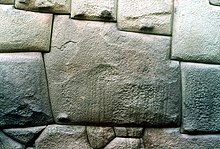
The twelve angle stone, in the Hatum Rumiyoc street of Cusco, is an example of Inca masonry.
This time period represents the era in which the civilization of the key Andes is almost completely dominated by the Inca Empire, which began its expansion in 1438. It lasted until the Castilian conquest in 1533. The Inca absorbed much technical skill from the cultures they conquered, and disseminated it, along with standard shapes and patterns, throughout their area of influence, which extended from Quito, Republic of ecuador to Santiago, Chile. Inca stonework is notably adept; giant stones are gear up and then tightly without mortar that a knife blade volition not fit in the gap.[100] Many of the Inca's monumental structures deliberately echoed the natural environment effectually them; this is particularly evident in some of the structures at Machu Picchu.[101] The Inca laid the city of Cusco in the shape of a puma, with the caput of the puma at Sacsayhuaman,[102] a shape that is yet discernible in aeriform photographs of the city today.
The iconography of Inca art, while clearly drawing from its many predecessors, is still recognizably Inca. Bronzework owes a clear debt to the Chimú, equally do a number of cultural traditions: the finest goods were reserved to the rulers, who wore the finest textiles, and ate and drank from aureate and silvery vessels.[103] As a result, Inca metalwork was relatively rare, and an obvious source of plunder for the conquering Spanish.
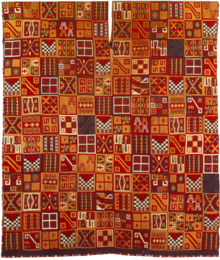
Textiles were widely prized inside the empire, in part as they were somewhat more than portable in the far-flung empire.[104]
Ceramics were made in large quantities, and, as with other media, in standardized shapes and patterns. One mutual shape is the urpu, a distinctive urn shape that came in a broad variety of standard capacities, much as modern storage containers do.[105] In spite of this standardization, many local areas retained some distinctive aspects of their culture in the works they produced; ceramics produced in areas under significant Chimú control prior to the Inca rule notwithstanding retain characteristics indicative of that fashion.[106]
Following the Spanish conquest, the art of the central Andes was significantly affected by the conflict and diseases brought by the Castilian. Early colonial period fine art, began to show influences of both Christianity and Inca religious and artistic ideas, and eventually also began to embrace new techniques brought by the conquerors, including oil painting on canvas.[107]
Early ceramics in northern South America [edit]
The earliest evidence of decorated pottery in South America is to be found in ii places. A multifariousness of sites in the Santarém region of Brazil contain ceramic sherds dating to a period between 5000 and 3000 BCE.[108] Sites in Colombia, at Monsú and San Jacinto independent pottery finds in different styles, and date as far back as 3500 BCE.[109] This is an area of agile research and subject to change.[110] The ceramics were decorated with curvilinear incisions. Another ancient site at Puerto Hormiga in the Bolívar Section of Colombia dating to 3100 BCE contained pottery fragments that included figured animals in a style related to later Barrancoid cultural finds in Republic of colombia and Venezuela.[109] Valdivia, Ecuador likewise has a site dated to roughly 3100 BCE containing decorated fragments, every bit well as figurines, many represent nude females. The Valdivian style stretched as far southward as northern Peru,[111] and may, co-ordinate to Lavallée, yet yield older artifacts.[108]
Past 2000 BCE, pottery was evident in eastern Venezuela. The La Gruta fashion, oft painted in cerise or white, included incised animal figures in the ceramic, also as ceramic vessels shaped as animal effigies. The Rancho Peludo style of western Venezuela featured relatively simple textile-type decorations and incisions.[111] Finds in the cardinal Andes dating to 1800 BCE and later appear to be derived from the Valdivian tradition of Republic of ecuador.[112]
Early on art in eastern Due south America [edit]
Relatively niggling is known most the early settlement of much of South America east of the Andes. This is due to the lack of stone (mostly required for leaving durable artifacts), and a jungle environment that rapidly recycles organic materials. Beyond the Andean regions, where the inhabitants were more than clearly related to the early on cultures of Peru, early finds are generally limited to littoral areas and those areas where there are stone outcrops. While there is show of human habitation in northern Brazil every bit early as 8000 BCE,[113] and rock art of unknown (or at all-time uncertain) age, ceramics appear to be the earliest artistic artifacts. The Mina civilization of Brazil (3000–1600 BCE) had simple round vessels with a carmine wash, that were stylistic predecessors to later Bahia and Guyanese cultures.[111]
Southern South America [edit]
The southern reaches of S America show evidence of human home as far dorsum equally ten,000 BCE. A site at Arroio do Fosseis on the pampa in southern Brazil has shown reliable evidence to that time,[114] and the Tierra del Fuego at the southern tip of the continent has been occupied since 7000 BCE.[115] Artistic finds are scarce; in some parts of Patagonia ceramics were never made, only existence introduced by contact with Europeans.[116]
Oceania [edit]
Australia [edit]
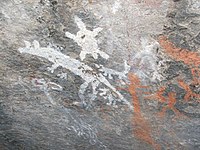
From earliest times Aboriginal and Torres Strait Islanders have been creating distinctive patterns of art. Much of the art is transitory, drawn in sand or on the human body to illustrate a place, a totem, or a cultural story. Early surviving artworks are by and large stone paintings. Some are called X-ray paintings considering they show the bones and organs of the animals they depict. Some Aboriginal fine art appears as abstruse to mod viewers; Ancient art employs geometrical figures, dots and lines to present the story beingness told.
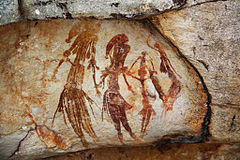
The Gwion Gwion stone art are 1 of many styles of rock art found in Western Australia. They are predominantly human figures fatigued in fine detail with accurate anatomical proportioning. They are commonly dated to exist at least 17,000 years erstwhile, and at that place have been suggestions they are every bit much every bit 70,000 years old.[117] The Sydney rock engravings are likewise a prominent rock art site in the country.[118]
Polynesia [edit]
The natives of Polynesia have a distinct artistic heritage. While many of their artifacts were fabricated with organic materials and thus lost to history, some of their nearly striking achievements survive in clay and stone. Among these are numerous pottery fragments from western Oceania, from the late 2nd millennium BCE. Also, the natives of Polynesia left scattered effectually their islands Petroglyphs, stone platforms or Marae, and sculptures of ancestor figures, the nearly famous of which are the Moai of Easter Island.
See too [edit]
- Çatalhüyük
- List of Stone Age art
- Nevalı Çori
- Prehistoric music
- Prehistoric religion
Notes [edit]
- ^ "The term "prehistoric" ceases to exist valid some thousands of years B.C. in the Eye Due east merely remains a warranted description down to about 500 A.D. in Ireland", Review by "A. T. 50." of Prehistoric Art by T. G. Eastward. Powell, The Journal of the Royal Club of Antiquaries of Ireland, Vol. 97, No. 1 (1967), p. 95, Royal Gild of Antiquaries of Ireland, JSTOR
- ^ a b c d St. Fleur, Nicholas (12 September 2018). "Oldest Known Drawing by Human Hands Discovered in South African Cave". The New York Times . Retrieved 15 September 2018.
- ^ "Vanquish 'art' made 300,000 years before humans evolved - New Scientist". New Scientist.
- ^ a b Joordens, Josephine C. A.; d'Errico, Francesco; Wesselingh, Frank P.; Munro, Stephen; de Vos, John; Wallinga, Jakob; Ankjærgaard, Christina; Reimann, Tony; Wijbrans, Jan R.; Kuiper, Klaudia F.; Mücher, Herman J. (2015). "Homo erectus at Trinil on Java used shells for tool product and engraving". Nature. 518 (7538): 228–231. Bibcode:2015Natur.518..228J. doi:10.1038/nature13962. ISSN 1476-4687. PMID 25470048. S2CID 4461751.
- ^ New York Times
- ^ The Metropolitan Museum of New York Metropolis Introduction to Prehistoric Art Retrieved 2012-5-12
- ^ Chase, pp. 145-146
- ^ Henshilwood, Christopher; Niekerk, Karen Loise van. "South Africa's Blombos cave is home to the earliest drawing past a human". The Chat . Retrieved 2020-02-17 .
- ^ "Discovery of the primeval drawing". ScienceDaily . Retrieved 2020-02-17 .
- ^ D. Fifty. Hoffmann; C. D. Standish; One thousand. García-Diez; P. B. Pettitt; J. A. Milton; J. Zilhão; J. J. Alcolea-González; P. Cantalejo-Duarte; H. Collado; R. de Balbín; M. Lorblanchet; J. Ramos-Muñoz; G.-Ch. Weniger; A. Westward. G. Pike (2018). "U-Thursday dating of carbonate crusts reveals Neandertal origin of Iberian cave fine art". Science. 359 (6378): 912–915. Bibcode:2018Sci...359..912H. doi:10.1126/science.aap7778. PMID 29472483.
- ^ Marris, Emma (22 February 2018). "Neanderthal artists made oldest-known cave paintings". Nature. doi:ten.1038/d41586-018-02357-8.
- ^ Feehly, Conor (six July 2021). "Beautiful Bone Carving From 51,000 Years Ago Is Changing Our View of Neanderthals". ScienceAlert . Retrieved half dozen July 2021.
- ^ Leder, Dirk; et al. (5 July 2021). "A 51,000-year-old engraved bone reveals Neanderthals' chapters for symbolic behaviour". Nature Ecology & Evolution. 594 (nine): 1273–1282. doi:x.1038/s41559-021-01487-z. PMID 34226702. S2CID 235746596. Retrieved 6 July 2021.
- ^ a b Zimmer, Carl (7 Nov 2018). "In Cavern in Borneo Jungle, Scientists Find Oldest Figurative Painting in the Earth - A cave drawing in Borneo is at least 40,000 years sometime, raising intriguing questions about creativity in ancient societies". The New York Times . Retrieved 8 Nov 2018.
- ^ a b Aubert, Yard.; et al. (7 Nov 2018). "Palaeolithic cavern art in Borneo". Nature. 564 (7735): 254–257. Bibcode:2018Natur.564..254A. doi:ten.1038/s41586-018-0679-9. PMID 30405242. S2CID 53208538.
- ^ "Indonesian Cave Paintings As Old As Europe's Ancient Art". NPR.org. 8 Oct 2014.
- ^ Portal, p. 25
- ^ a b Portal, p. 26
- ^ Coulson, pp. 150–155
- ^ Thackeray.
- ^ Azerbaijan, Azerbaijan (2005). Republic of azerbaijan. Cavendish Square Publishing. pp. xviii. ISBN9780761420118.
- ^ Azerbaijan: Mosques, Turrets, Palaces, Republic of azerbaijan: Mosques, Turrets, Palaces (1979). Azerbaijan: Mosques, Turrets, Palaces. Corvina Kiadó. p. 8. ISBN9789631303216.
{{cite book}}: CS1 maint: multiple names: authors list (link) - ^ A Historical Atlas of Azerbaijan (Historical Atlases of South asia, Primal Asia, and The Middle E), A Historical Atlas of Azerbaijan (Historical Atlases of South asia, Fundamental Asia, and The Centre E) (2004). A Historical Atlas of Azerbaijan (Historical Atlases of South asia, Central Asia, and The Middle East). Rosen Pub Group. p. 11. ISBN978-0823944972.
{{cite book}}: CS1 maint: multiple names: authors listing (link) - ^ "The Stone Engravings of Gobustan". donsmaps.com . Retrieved 2019-02-07 .
- ^ Pre-Columbian Trans-Oceanic Contact. Lulu.com. 2016. p. 98. ISBN978-1329972162. [ self-published source ]
- ^ Mathpal, Yashodhar (1984). Prehistoric Painting Of Bhimbetka. Abhinav Publications. p. 220. ISBN9788170171935.
- ^ Tiwari, Shiv Kumar (2000). Riddles of Indian Rockshelter Paintings. Sarup & Sons. p. 189. ISBN9788176250863.
- ^ Rock Shelters of Bhimbetka (PDF). UNESCO. 2003. p. 16.
- ^ Mithen, Steven (2011). Subsequently the Ice: A Global Human History, twenty,000 - 5000 BC. Orion. p. 524. ISBN9781780222592.
- ^ Javid, Ali; Jāvīd, ʻAlī; Javeed, Tabassum (2008). World Heritage Monuments and Related Edifices in India. Algora Publishing. p. 19. ISBN9780875864846.
- ^ Portal, p. 27
- ^ Portal, p. 29
- ^ Portal, p. 33
- ^ Portal, pp. 34–35
- ^ Portal, p. 38
- ^ Portal, p. 39
- ^ Portal, p. 40
- ^ Portal, p. 41
- ^ Sagona, Claudia (2015-08-25). The Archeology of Malta. Cambridge University Press. p. 47. ISBN9781107006690 . Retrieved 25 November 2016.
- ^ Back-scratch, Andrew (November 2008). "Gobekli Tepe: The Globe'due south First Temple?". Smithsonian.com. Retrieved August ii, 2013.
- ^ Sandars, 75-98
- ^ "Rock Drawings in Valcamonica" (PDF).
- ^ Sandars, Nancy Chiliad., Prehistoric Art in Europe, Penguin (Pelican, now Yale, History of Art), pp. 87-96, 1968 (nb 1st edn.)
- ^ "11,000 twelvemonth former pendant is primeval known Mesolithic art in Britain", University of York
- ^ Geggel, Laura (April 25, 2018). "This Eerie, Homo-Similar Figure Is Twice Every bit Onetime Equally Arab republic of egypt's Pyramids". Live Science . Retrieved Apr 28, 2018.
- ^ Borić, Dušan; Hanks, Bryan; Šljivar, Duško; Kočić, Miroslav; Bulatović, Jelena; Griffiths, Seren; Doonan, Roger; Jacanović, Dragan (June 2018). "Enclosing the Neolithic World: A Vinča Civilisation Enclosed and Fortified Settlement in the Balkans". Current Anthropology. 59 (3): 336–345. doi:10.1086/697534. hdl:11573/1545302. S2CID 150068332.
- ^ Coulson, p. 86
- ^ Coulson, pp. 80–82
- ^ Unesco World Heritage designation.
- ^ Mire, Sada (2008). "The Discovery of Dhambalin Stone Art Site, Somaliland". African Archaeological Review. 25 (3–4): 153–168. doi:10.1007/s10437-008-9032-two. S2CID 162960112. Archived from the original on 27 June 2013. Retrieved 22 June 2013.
- ^ Alberge, Dalya (17 September 2010). "United kingdom archeologist finds cave paintings at 100 new African sites". The Guardian . Retrieved 25 June 2013.
- ^ Coulson, p. 147
- ^ Coulson, pp. 156–160
- ^ Coulson, pp. 160–162,205
- ^ "Ice Age Fine art from Florida." Past Horizons. 23 June 2011 (retrieved 23 June 2011)
- ^ Bement, Leland C. Bison hunting at Cooper site: where lightning bolts drew thundering herds. Norman: University of Oklahoma Printing, 1999: 37, 43, 176. ISBN 978-0-8061-3053-8.
- ^ Friedman, Florence Dunn (September 1998). "Ancient Egyptian faience". Archived from the original on 2004-10-twenty. Retrieved 2008-12-22 .
- ^ Wilford, John Noble. Scientist at Piece of work: Anna C. Roosevelt; Abrupt and To the Bespeak In Amazonia. New York Times. 23 April 1996
- ^ "Dating a Paleoindian Site in the Amazon in Comparison with Clovis Civilisation." Scientific discipline. March 1997: Vol. 275, no. 5308, pp. 194801952. (retrieved 1 Nov 2009)
- ^ Stone-Miller, 17
- ^ Lavallée, p. 88
- ^ Lavallée, p. 94
- ^ Lavallée, p. 115
- ^ Lavallée, p. 186
- ^ Bruhns, p. 80
- ^ Rock-Miller, pp. 19–20
- ^ Stone-Miller, p. 21
- ^ Rock-Miller, p. 27
- ^ Stone-Miller, p. 22
- ^ Stone-Miller, pp. 28–29
- ^ Stone-Miller, p. 40
- ^ Stone-Miller, p. 44
- ^ Rock-Miller, p. 46
- ^ Stone-Miller, p. 49
- ^ Stone-Miller, p. 50
- ^ Stone-Miller, p. 58
- ^ Rock-Miller, p. 67
- ^ Stone-Miller, pp. 74–75
- ^ Stone-Miller, pp. 78–82
- ^ Stone-Miller, p. 83
- ^ Rock-Miller, p. 88
- ^ Stone-Miller, p. 86
- ^ Stone-Miller, p. 92
- ^ Stone-Miller, pp. 121–123
- ^ Stone-Miller, p. 119
- ^ Stone-Miller, pp. 131–134
- ^ Stone-Miller, p. 136
- ^ Rock-Miller, pp. 138–139
- ^ Stone-Miller, pp. 146–148
- ^ Rock-Miller, pp. 149–150
- ^ a b Stone-Miller, p. 151
- ^ Stone-Miller, p. 153
- ^ Stone-Miller, p. 154
- ^ Stone-Miller, p. 156
- ^ Rock-Miller, pp. 156–158
- ^ Rock-Miller, p. 160
- ^ Stone-Miller, pp. 175–177
- ^ a b Rock-Miller, p. 179
- ^ Stone-Miller, p. 180
- ^ Stone-Miller, p. 181
- ^ Stone-Miller, p. 190
- ^ Stone-Miller, p. 194
- ^ Stone-Miller, p. 186
- ^ Stone-Miller, p. 209
- ^ Stone-Miller, p. 215
- ^ Stone-Miller, p. 216
- ^ Rock-Miller, p. 217
- ^ a b Lavallée, p. 182
- ^ a b Bruhns, pp. 116–117
- ^ Lavallée, pp. 176–182
- ^ a b c Bruhns, pp. 117–118
- ^ Bruhns, p. 119
- ^ Lavallée, p. 113
- ^ Lavallée, p. 108
- ^ Lavallée, p. 112
- ^ Lavallée, p. 187
- ^ Bradshaw Foundation. "The Bradshaw Paintings - Australian Stone Fine art Archive". Bradshaw Foundation.
- ^ Bowdler, Sandra. "Balls Head: the excavation of a Port Jackson rock shelter. Records of the Australian Museum 28(7): 117–128, plates 17–21. [4 October 1971]" (PDF). AUSTRALIAN MUSEUM SCIENTIFIC PUBLICATIONS. Australian Museum. Retrieved April 28, 2012.
References [edit]
- Arbib, Michael A (2006). Activity to language via the mirror neuron system: The Mirror Neuron System. Cambridge University Press. ISBN978-0-521-84755-one.
- Bailey, Douglass (2005). Prehistoric Figurines: Representation and Corporeality in the Neolithic. Routledge Publishers. ISBN978-0-415-33152-iv.
- Bruhns, Karen O (1994). Aboriginal South America . Cambridge Academy Press. ISBN978-0-521-27761-seven.
- Chase, Philip K (2005). The Emergence of Culture: The Development of a Uniquely Homo Fashion of Life. Birkhäuser. ISBN978-0-387-30512-seven.
- Coulson, David; Campbell, Alec (2001). African Rock Art. Harry N. Abrams, Inc. ISBN978-0-8109-4363-6.
- Lavallée, Danièle (1995). The First South Americans. Bahn, Paul Thou (trans.). University of Utah Printing. ISBN978-0-87480-665-6.
- Portal, Jane (2000). Korea: Art and Archaeology . Thames & Hudson. ISBN9780500282021.
- Sandars, Nancy Thou., Prehistoric Fine art in Europe, Penguin (Pelican, now Yale, History of Art), 1968 (nb 1st edn.)
- Stone-Miller, Rebecca (1995). Art of the Andes . Thames and Hudson. ISBN978-0-500-20286-9.
- Thackeray, Anne I.; Thackeray, JF; Beaumont, Pb; Vogel, JC; et al. (1981-10-02). "Dated Rock Engravings from Wonderwerk Cavern, South Africa". Science. 214 (4516): 64–67. Bibcode:1981Sci...214...64T. doi:10.1126/science.214.4516.64. PMID 17802575. S2CID 29714094.
- "Unesco World Heritage declaration on Twyfelfontein". Retrieved 2008-11-xiii .
External links [edit]
- RockArtScandinavia Tanums Hällristningsmuseum Underslös. Stone art research center.
- EuroPreArt database of European Prehistoric Art
- Lepenski Vir
- Göbekli Tepe, in German
- Nevali Cori
- Prehistoric Fine art Expressions from India
- http://witcombe.sbc.edu/ARTHprehistoric.html#full general
- http://donsmaps.com/combarelles.html
- Human Timeline (Interactive) – Smithsonian, National Museum of Natural History (Baronial 2016).
barnettcoutionizies.blogspot.com
Source: https://en.wikipedia.org/wiki/Prehistoric_art
0 Response to "He Subject Matter of Prehistoric Art Concentrates on Sources of Food and"
Post a Comment